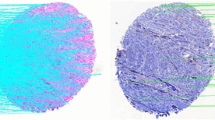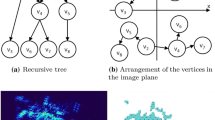Abstract
Model-based invariants are relations between model parameters and image measurements, which are independent of the imaging parameters. Such relations are true for all images of the model. Here we describe an algorithm which, given L independent model-based polynomial invariants describing some shape, will provide a linear re-parameterization of the invariants. This re-parameterization has the properties that: (i) it includes the minimal number of terms, and (ii) the shape terms are the same in all the model-based invariants. This final representation has 2 main applications: (1) it gives new representations of shape in terms of hyperplanes, which are convenient for object recognition; (2) it allows the design of new linear shape from motion algorithms. In addition, we use this representation to identify object classes that have universal invariants.
Similar content being viewed by others
References
J.B. Burns, R. Weiss, and E. Riseman, “View variation of pointset and line segment features,” IEEE Transactions on Pattern Analysis and Machine Intelligence, Vol. 15, No. 1, pp. 51–68, 1993.
S. Carlsson and D. Weinshall, “Duality of reconstruction and positioning from projective views,” International Journal of Computer Vision, Vol. 27, No. 3, pp. 227–241, 1998.
D.T. Clemens and D.W. Jacobs, “Space and time bounds on indexing 3-D models from 2-D images,” IEEE Transactions on Pattern Analysis and Machine Intelligence, Vol. 13, No. 10, pp. 1007–1017, 1991.
O. Faugeras and B. Mourrain, “On the geometry and algebra of the point and line correspondences between N images,” in Proceeding of the Europe-China Workshop on Geometrical Modeling and Invariant for Computer Vision, Xidian University Press, 1995.
R. Hartley, “Lines and points in three views–An integrated approach,” in Proceedings Image Understanding Workshop, San Mateo, CA, Morgan Kaufmann Publishers, Inc., 1994, pp. 1009–1016.
D.W. Jocobs, “Matching 3-D models to 2-D images,” International Journal of Computer Vision, Vol. 21, No. 1, pp. 123–153, 1997.
R. Kumar and A.R. Hanson, “Sensitivity of the pose refinement problem to accurate estimation of camera parameters,” in Proceedings of the 3rd International Conference on Computer Vision, Osaka, Japan, IEEE: Washington, DC, 1990, pp. 365–369.
H.C. Longuet-Higgins, “A computer algorithm for reconstructing a scene from two projections,” Nature,Vol. 293, pp. 133–135, 1981.
Q.-T. Luong and O. Faugeras, “The fundamental matrix: Theory, algorithms, and stability analysis,” International Journal of Computer Vision, Vol. 17, No. 1, pp. 43–75, 1996.
Y. Moses and S. Ullman, “Limitations of non model-based recognition schemes,” in Proc. 2nd European Conf. on Computer Vision, Lecture Notes in Computer Science, G. Sandini (Ed.), Springer Verlag, 1992, Vol. 588, pp. 820–828.
L. Quan, “Invariants of 6 points from 3 uncalibrated images,” in Proceedings of the 3rd European Conference on Computer Vision, Stockholm, Sweden, Springer-Verlag, 1994, pp. 459–470.
C.A. Rothwell, D.A. Forsyth, A. Zisserman, and J.L. Mundy, “Extracting projective structure from single perspective views of 3d point sets,” in Proceedings of the 4th International Conference on Computer Vision, Berlin, Germany, IEEE: Washington, DC, 1993, pp. 573–582.
H.S. Sawhney, J. Oliensis, and A.R. Hanson, “Description and reconstruction from image trajectories of rotational motion,” in Proceedings of the 3rd International Conference on Computer Vision, Osaka, Japan, IEEE: Washington, DC, 1990, pp. 494–498.
A. Shashua, “Trilinearity in visual recognition by alignment,” in Proceedings of the 3rd European Conference on Computer Vision, Stockholm, Sweden, May 1994.
B. Triggs, “The geometry of projective reconstruction I: Matching constraints and the joint image,” Technical Report, LIFIA, INRIA Rhone Alpes, 1994.
D. Weinshall, “Model-based invariants for 3D vision,” International Journal of Computer Vision, Vol. 10, No. 1, pp. 27-42.
D. Weinshall, M. Werman, and A. Shashua, “Shape tensors for efficient and learnable indexing,” in Proceedings of the IEEE Workshop on Representations ofVisual Scenes, Cambridge, MA, 1995.
M. Werman and A. Shashua, “Elimination: An approach to the study of 3D-from-2D,” in Proceedings of the 1st International Conference on Computer Vision, June 1995.
M. Werman and D. Weinshall, “Complexity of indexing: Efficient and learnable large database indexing,” in Proceedings of the 4th European Conference on Computer Vision, Cambridge, UK, Springer-Verlag, 1996.
Author information
Authors and Affiliations
Rights and permissions
About this article
Cite this article
Weinshall, D. Minimal Decomposition of Model-Based Invariants. Journal of Mathematical Imaging and Vision 10, 75–85 (1999). https://doi.org/10.1023/A:1008326801364
Issue Date:
DOI: https://doi.org/10.1023/A:1008326801364




